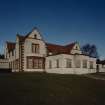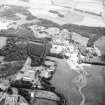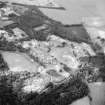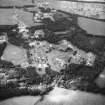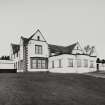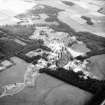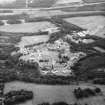Dechmont, Bangour Village Hospital, Villa 9
Psychiatric Hospital (20th Century)
Site Name Dechmont, Bangour Village Hospital, Villa 9
Classification Psychiatric Hospital (20th Century)
Canmore ID 248434
Site Number NT07SW 18.07
NGR NT 03386 71074
Datum OSGB36 - NGR
Permalink http://canmore.org.uk/site/248434
- Council West Lothian
- Parish Ecclesmachan
- Former Region Lothian
- Former District West Lothian
- Former County West Lothian
3-bay extension to S. 2-storey with breaking-eaves dormers, 5- by 4-bay, gabled, restrained Scots Renaissance style hospital villa. Rendered snecked sandstone rubble with contrasting ashlar margins and alternate quoins. Base course, cornice; raised margins, shouldered gables. Pedimented and round-arched dormer heads. Some bi-partite windows.
Bangour Village Hospital is the best surviving example in Scotland of a psychiatric hospital created in the village system of patient care, a revolutionary concept in the late 19th century. This is a prominent and imposing detached former ward villa with good proportions and fine architectural detailing. Its villa form epitomises the village philosophy of the original intent for Bangour Village Hospital and is an integral and important part of the complex. Designed in a Scots Renaissance style, the villa has the round-arched dormerheads, gables and red roof tiles. The dormitory block, latterly known as Villa 19, was one of 4 large villas built at Bangour hospital for female patients who required little supervision and who could be employed in tasks. Nurses also lived in the villas which was characteristic of the village or colony philosophy of the psychiatric hospital, then known as a lunatic asylum. The patients who were housed here would have been employed in doing needlework and embroidery.
The buildings of the Bangour Village Hospital sit within their original rural setting and remain largely externally unaltered. Villas 18 -21 lie in an undulating line from E to W, each within their own surrounding space. There were 2 designs for these buildings and this one and Villa No 20 (see separate listing) are the same pattern. The 4 villas accommodated 190 patients and each was constructed to be furnished as ordinary houses and with no single rooms and with public rooms on the ground floor and dormitories above. Male patients were accommodated in earlier, temporary shelters to the N of these.
The village system of patient care, exemplified by the Alt-Scherbitz hospital, near Leipzig in Germany in the 1870s encouraged psychiatric patients to be cared for within their own community setting, where there were few physical restrictions and where village self-sufficiency was encouraged. This was in contrast to the large contemporary asylum buildings. This philosophy had been gradually developing in a number of Scottish institutions, but Bangour saw its apotheosis, specifically in relation to psychiatric patients. Two other hospitals were built in Scotland for psychiatric patients, Kingseat, to the north of Aberdeen (built in 1904) and Dykebar Hospital in Paisley, 1909 (see separate listing). These have not survived as completely as Bangour.
The hospital was built by the well-known Edinburgh architect Hippolyte J. Blanc as a result of a competition begun in 1898. The Edinburgh Lunacy Board had concluded that a new psychiatric hospital was required to cater for the increasing numbers of patients from Edinburgh and the hospital was opened in 1906, with some of the buildings still to be completed. It was designed with no external walls or gates. The utility buildings were positioned at the centre of the site, the medical buildings for patients requiring medical supervision and treatment were to the E and there were villas to the W of the site which could accommodate patients who required less supervision and were able to work at some sort of industry. The complex also included a farm to the NW (not part of the current site) and had its own water and electricity systems and also had its own railway. The hospital was commissioned by the War Office in WWI for wounded soldiers and extra temporary structures were erected, most of which were dismantled after the War although some timber ones were retained by the hospital. The railway too was dismantled in 1921. The patients returned in 1922. The hospital was commissioned again for WWII. At this time many temporary shelters were erected to the NW of the site and this became the basis of the Bangour General Hospital (now demolished). Bangour Village Hospital continued as a psychiatric hospital until 2004.
Hippolyte J Blanc (1844-1917) was an eminent and prolific Edinburgh-based architect who was perhaps best known for his Gothic revival churches. He was also a keen antiquarian and many of his buildings evoke an earlier historic Scottish style.
List description revised, 2012. Villa formerly listed at category A as part of a single listing covering Bangour Village Hospital. Category changed to C(S) following listing review, 2012. (Historic Scotland)

















